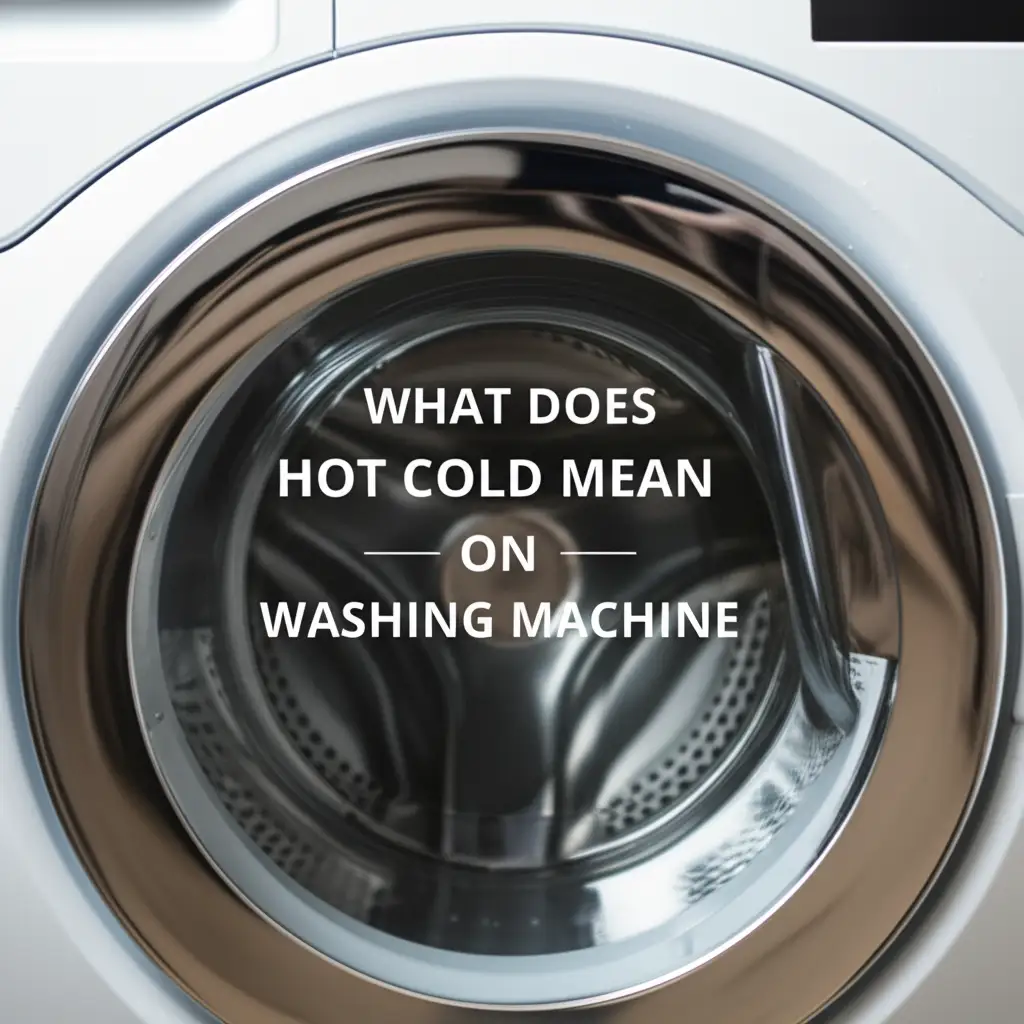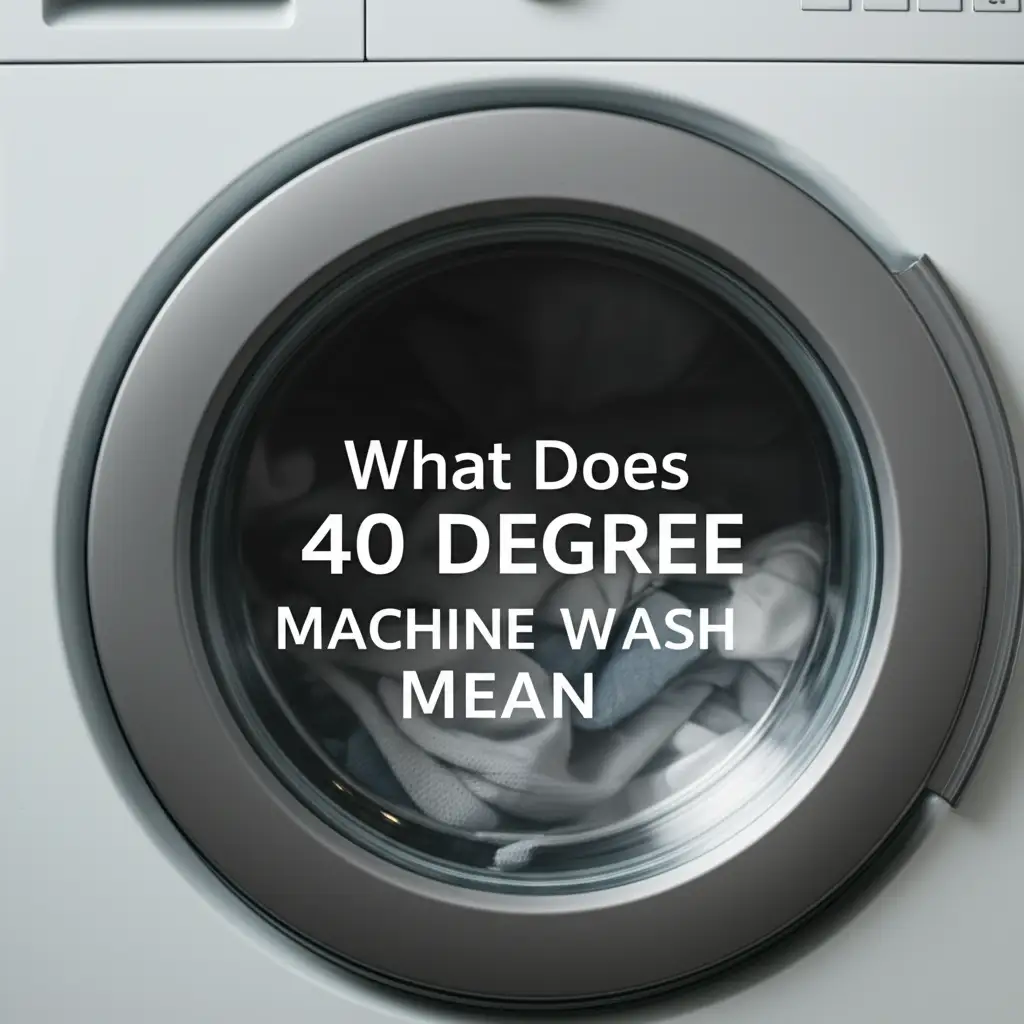· Tessa Winslow · Appliance Guides · 16 min read
What Does Hot Cold Mean On Washing Machine

Decoding Washing Machine Temperatures: What Does Hot Cold Mean On Washing Machine?
Have you ever stood in front of your washing machine, puzzled by the various temperature settings? Understanding what “hot,” “cold,” and “warm” mean on your washing machine is important. These settings do more than just change the water temperature. They affect how clean your clothes get, how long they last, and even your energy bill.
Many people simply pick a setting without knowing its true impact. This article will explain the meaning behind these temperature options. We will discuss when to use each one. You will learn how to choose the right temperature for different fabrics and stains. This guide helps you make informed choices every time you do laundry. We will also touch on how these choices impact your washing machine’s performance.
Takeaway
- Hot water cleans heavily soiled items and sterilizes. It can shrink fabrics and fade colors.
- Cold water saves energy and protects delicate items. It helps colors stay vibrant.
- Warm water balances cleaning power and fabric protection. It works for most daily loads.
- Always check fabric care labels for the best washing instructions.
- Choosing the right temperature prolongs clothing life and saves money.
What Does Hot Cold Mean On Washing Machine?
On a washing machine, “hot,” “cold,” and “warm” refer to the water temperature settings for the wash cycle. “Hot” uses heated water, usually around 130°F (54°C) or higher. “Cold” uses unheated tap water, typically 60-80°F (15-27°C). “Warm” combines hot and cold water to reach a moderate temperature, often 90-110°F (32-43°C). Each setting provides specific benefits for different laundry needs.
Understanding Your Washing Machine’s Water Temperature Settings
Every washing machine has basic water temperature options. These are typically hot, warm, and cold. Each setting pulls water into the machine at a specific temperature. The machine mixes hot and cold water from your home’s supply to achieve the desired warmth. Knowing how these settings work is important for effective laundry.
Your washing machine connects to both a hot and a cold water supply. When you select a temperature, the machine opens valves accordingly. For cold water, only the cold water valve opens. For hot water, only the hot water valve opens. For warm water, both valves open, and the machine mixes the water to reach a middle temperature. This system ensures you get the exact water temperature needed for your wash load. Understanding these basics helps you make better laundry decisions. It also helps in understanding what goes where in a washing machine.
The Basics of Hot, Warm, and Cold Water
Hot water provides the most cleaning power. It works best for heavily soiled items and sanitization. However, it can damage certain fabrics. Cold water saves energy and is gentle on delicate clothes. It helps prevent shrinking and fading. Warm water offers a good balance. It cleans well without being too harsh on most clothes.
I always consider the fabric type and soil level before picking a temperature. For instance, I use cold water for bright colors to keep them from fading. For my white towels, hot water is the best choice to get them truly clean and germ-free. Picking the right temperature improves your laundry results. It also helps your clothes last longer.
How Your Machine Mixes Water
Modern washing machines use internal thermostats and sensors. These ensure the water reaches the selected temperature. Some machines have advanced features. They might adjust the mix based on the load size or type. This helps maintain consistent washing conditions.
Older models might not have as precise temperature control. They simply mix water based on valve openings. Regardless of your machine’s age, the core function remains the same. It brings in water at your chosen temperature. This process is key to how your machine operates.
When to Choose Hot Water for Laundry
Hot water offers excellent cleaning and sanitizing power. It is perfect for items that need deep cleaning. Think about what goes into your laundry basket. Heavily soiled clothes, white linens, and items needing germ removal often benefit from hot water. Hot water helps dissolve detergents more effectively. It also breaks down stubborn stains and oils.
I often use hot water for my kitchen towels. They can get very dirty with food spills and grease. The hot water cuts through the grime. It leaves them feeling fresh and clean. This temperature setting is a powerful tool in your laundry routine.
Benefits of Hot Water Washing
Hot water is very effective at removing tough dirt and grime. It also kills most bacteria and germs. This makes it ideal for sanitizing. If someone in your home is sick, washing their clothes in hot water can help prevent the spread of germs. Hot water is also good for dissolving oily stains.
When I deal with greasy marks on clothes, hot water is my first choice. It helps loosen the oil from the fabric fibers. This allows the detergent to work better. Using hot water ensures a thorough clean, especially for items that come into contact with germs or heavy dirt.
Ideal Items for Hot Washes
You should use hot water for:
- White fabrics: Towels, sheets, and white clothing benefit from hot water. It helps keep them bright and removes stains.
- Heavily soiled items: Work clothes, garden clothes, or items with stubborn dirt.
- Items needing sanitization: Diapers, bedding from sick family members, or pet beds. For example, knowing can I put cat bed in washing machine means choosing the right temperature for hygiene.
- Greasy or oily stains: Hot water helps break down these challenging spots. For tips on specific stains, you might check how to get oil out of washing machine.
Always check fabric care labels. Some delicate fabrics cannot withstand high temperatures. Using hot water on them can cause shrinking or damage. Use hot water wisely for best results.
The Benefits and Uses of Cold Water Washing
Cold water washing is a popular choice for many reasons. It is gentle on fabrics and saves energy. This setting uses water directly from your cold water supply. No energy is needed to heat it. This reduces your utility bills. Cold water also helps preserve fabric integrity and color.
I almost always choose cold water for my everyday clothes. Jeans, t-shirts, and most colored items go into a cold wash. This keeps them looking new longer. It prevents fading and shrinking. Cold water washing is an environmentally friendly option.
Energy Savings with Cold Water
Heating water for laundry uses a lot of energy. In fact, water heating can account for a significant portion of your laundry’s energy consumption. Choosing cold water significantly reduces this energy use. This means lower electricity or gas bills for your home. It also reduces your carbon footprint.
I have noticed a difference in my energy bill since switching most of my loads to cold water. It is a simple change that makes a real impact. This small action helps both my wallet and the planet. Cold water washing is a smart choice for modern households.
Protecting Delicates and Colors
Cold water is kind to your clothes. It helps prevent colors from bleeding or fading. This is especially true for dark or brightly colored garments. It also reduces the risk of shrinking. Delicates like silk, lace, or wool also do well in cold water. Hot water can damage these sensitive materials.
When I wash my delicate blouses, I always use cold water. It keeps the fabric from stretching or losing its shape. Cold water maintains the vibrancy of my colored clothes. This ensures they look good for many washes. For more precise temperature control related to fabric care, you might explore what does 40 degree machine wash mean.
Common Misconceptions About Cold Water
Some people believe cold water does not clean as well. This is often not true. Modern detergents are formulated to work effectively in cold water. They contain enzymes that break down dirt at lower temperatures. Unless you have extremely soiled items, cold water usually cleans well enough.
Another myth is that cold water leaves clothes smelling damp. This happens if clothes sit too long after washing. Proper drying is key regardless of water temperature. I always transfer my clothes to the dryer quickly. This prevents any musty smells. Cold water washing is a powerful and efficient option.
Decoding Warm Water: The Balanced Approach
Warm water provides a middle ground between hot and cold. It is a versatile choice for many laundry loads. This temperature setting combines the gentle nature of cold water with some of the cleaning power of hot water. It is often recommended for permanent press items. It also works well for moderately dirty clothes.
I find warm water to be a reliable option for most of my everyday laundry. It gets clothes clean without being harsh. It also requires less energy than hot water. This balance makes warm water a practical choice for many households. It handles a wide range of fabrics and soil levels.
When Warm Water is Your Best Bet
Warm water is ideal for:
- Moderately soiled items: Everyday clothes that are not heavily stained but need a good clean.
- Permanent press fabrics: These fabrics often benefit from warm water to help prevent wrinkles.
- Mixed loads: If you have a mix of colors and whites that are not heavily soiled, warm water can be a safe bet.
- Synthetic fabrics: Many synthetic blends clean well in warm water.
I often use warm water for my bedding that isn’t white. It cleans them effectively while still being gentle on the fabric. It provides a thorough wash without the risk of shrinking or excessive fading. Warm water offers a good balance of cleaning and care.
Combining Benefits
Warm water combines some advantages of both hot and cold washing. It helps dissolve detergents better than cold water. This can lead to a more effective clean. At the same time, it is less likely to cause shrinking or fading than hot water. It strikes a good balance for general laundry needs.
This setting uses less energy than a hot wash. However, it uses more than a cold wash. It represents a compromise. It balances cleaning power with energy efficiency and fabric protection. This makes it a popular choice for many people. It ensures clothes come out clean and well-preserved.
Factors Influencing Your Temperature Choice
Choosing the right water temperature for your laundry involves several considerations. It is not just about personal preference. Factors like fabric type, the type of stains, and hygiene needs all play a role. Making the correct choice ensures your clothes are clean. It also helps them last longer.
I always take a moment to sort my laundry. I separate darks from lights and delicates from sturdy items. This helps me decide on the best water temperature. Thinking about these factors prevents damage to clothes. It also optimizes cleaning results.
Fabric Type and Care Labels
The care label inside your garment is your best guide. It provides specific instructions for washing. This includes recommended water temperature. Silk, wool, and delicate synthetics usually require cold water. Cotton and linen can often handle warmer temperatures. Ignoring care labels can lead to shrinking, fading, or stretching.
I always check the labels, especially for new clothes. Some items might specify “hand wash cold” or “machine wash warm.” Following these instructions protects your investment. It also keeps clothes looking their best. Different fabrics react differently to heat.
Stain Type and Soil Level
Different stains respond better to specific temperatures. Protein-based stains like blood or dairy should be washed in cold water first. Hot water can set these stains, making them harder to remove. Oily stains, however, often lift more effectively with warm or hot water. For heavily soiled items, hotter water generally provides a deeper clean.
If I have clothes with grass stains or mud, I often pre-treat them. Then I wash them in a temperature that matches the fabric. For oil stains, warm water is my choice. Understanding stain types helps me choose the right temperature for effective removal.
Hygiene Concerns
For items that need to be sanitized, hot water is the most effective. This includes baby clothes, reusable diapers, and bedding from someone sick. The high temperature helps kill bacteria and germs. If hygiene is a primary concern, hot water provides the best results.
I make sure to use hot water for specific loads. For example, after my children have been sick, I wash their bedding on the hot cycle. This gives me peace of mind. It ensures everything is thoroughly clean and sanitized.
Beyond Temperature: Other Washing Machine Settings
While water temperature is key, washing machines offer other important settings. These settings work together with temperature to provide a thorough and effective wash. Understanding these extra features enhances your laundry results. It also helps you care for your machine.
I often combine temperature choices with specific wash cycles. This ensures my clothes receive the best treatment. For example, a delicate cycle with cold water works wonders for my sweaters. A heavy-duty cycle with hot water cleans my work clothes.
Cycle Types and Their Impact
Most washing machines have various wash cycles. Common cycles include:
- Normal/Cotton: For everyday loads, usually combines vigorous agitation with different temperatures.
- Delicates/Gentle: Uses slow agitation and is best for fragile items. Often paired with cold water.
- Permanent Press: Designed to minimize wrinkles. It often uses warm water with a cold rinse.
- Heavy Duty: For heavily soiled or bulky items. It uses more water and longer, stronger agitation.
- Bulky Items/Sheets: Specific cycles for large items like blankets or comforters.
Each cycle is designed for different fabric types and soil levels. Choosing the right cycle along with the right temperature is crucial. For instance, if you are curious about what does soak mean on a washing machine, that setting adds a pre-wash soak to help loosen dirt, often used with varying temperatures.
Detergent Compatibility
Different detergents are formulated for different temperatures. Standard detergents work well in warm or hot water. High-efficiency (HE) detergents are designed to clean effectively in cold water. They produce fewer suds. Always use an HE detergent in an HE machine, regardless of temperature.
Using the wrong detergent type can lead to problems. Too many suds can damage your machine. Not enough cleaning power can leave clothes dirty. I always check my detergent’s label. I make sure it matches my machine and my chosen water temperature. This small step ensures better cleaning.
Maximizing Efficiency and Longevity of Your Washing Machine
Choosing the right hot and cold settings helps your laundry. It also impacts your washing machine’s life. Proper use and maintenance keep your appliance running smoothly. It ensures your investment lasts longer. Understanding how your machine works helps you take better care of it.
I always try to follow maintenance tips for my washing machine. It prevents costly repairs. It also ensures my clothes get consistently clean. A well-maintained machine is an efficient machine. For example, knowing how to clean top loader washing machine can extend its life.
Tips for Optimal Laundry Results
- Sort clothes properly: Separate by color, fabric type, and soil level. This helps you choose the best temperature and cycle.
- Pre-treat stains: Address tough stains before washing. This improves their removal chances, regardless of water temperature.
- Don’t overload: An overloaded machine cannot clean effectively. It also puts strain on the motor.
- Use the right detergent: Match the detergent type to your machine and water temperature.
- Check care labels: Always follow garment care instructions for best results and to prevent damage.
By following these tips, you will get cleaner clothes. You will also extend the life of your garments. Good laundry habits make a big difference. They ensure your clothes always look their best.
Machine Maintenance for Performance
Regular maintenance keeps your washing machine efficient. Here are some tips:
- Clean your machine regularly: Run a cleaning cycle with a washing machine cleaner or vinegar. This removes detergent residue and prevents odors.
- Check hoses: Inspect hot and cold water hoses for cracks or leaks periodically. Replace them if you see any damage.
- Clean the dispenser: Remove and clean the detergent and fabric softener dispensers. Residue can build up.
- Leave the door ajar: After a wash, leave the door of a front-loader slightly open. This allows air circulation and prevents mildew.
- Don’t overuse detergent: Too much detergent creates excessive suds. This can leave residue on clothes and in the machine.
Following these maintenance steps helps your washing machine perform at its best. It prevents issues related to water flow and temperature. A well-cared-for machine provides years of reliable service.
FAQ Section
What temperature is best for towels?
For white towels, hot water is best for sanitizing and deep cleaning. It helps remove bacteria and keeps them bright. For colored towels, warm water is a safer choice to prevent fading while still cleaning effectively. Cold water can work for lightly soiled towels, saving energy.
Can I wash all clothes in cold water?
You can wash most clothes in cold water, especially with modern detergents designed for it. Cold water saves energy and protects colors. However, for heavily soiled items, whites needing brightening, or items requiring sanitization, warmer temperatures are more effective. Always check fabric care labels first.
Does hot water shrink clothes?
Yes, hot water can shrink certain fabrics, particularly natural fibers like cotton, wool, and linen. The heat causes the fibers to tighten. This leads to shrinkage. Always check the care label on your clothing. If shrinkage is a concern, opt for cold or warm water.
What is the difference between cold and tap cold?
“Cold” typically refers to unheated tap water. “Tap Cold” means the exact same thing. Some machines use “Tap Cold” to emphasize that no energy is used for heating. It ensures you get water at your home’s unheated tap water temperature, which varies by season and location.
How do I know if my washing machine uses hot water?
Most washing machines have specific settings or indicators for “Hot,” “Warm,” and “Cold.” When you select “Hot,” the machine should draw water from your home’s hot water supply line. You can often feel the machine’s water intake hose warm up. Also, the water inside the drum will be noticeably warm.
Is it okay to mix hot and cold water in one load?
No, you do not mix hot and cold water manually in one load. Your washing machine does this automatically when you select the “Warm” temperature setting. It draws from both hot and cold supply lines to achieve a balanced, moderate temperature. You simply choose the desired setting, and the machine handles the mixing.
Conclusion
Understanding what “hot cold” means on your washing machine empowers you to make better laundry choices. It is not just about getting clothes clean. It is about preserving them, saving energy, and ensuring proper hygiene. Each temperature setting – hot, warm, and cold – offers distinct benefits. Knowing when to use each one transforms your laundry routine.
By paying attention to fabric care labels, stain types, and your household’s needs, you can choose the optimal water temperature. This smart approach extends the life of your garments. It also makes your washing machine more efficient. Take control of your laundry. Make informed decisions about your washing machine settings. Your clothes will thank you. For more insights into optimizing your home appliances, explore our other articles.





